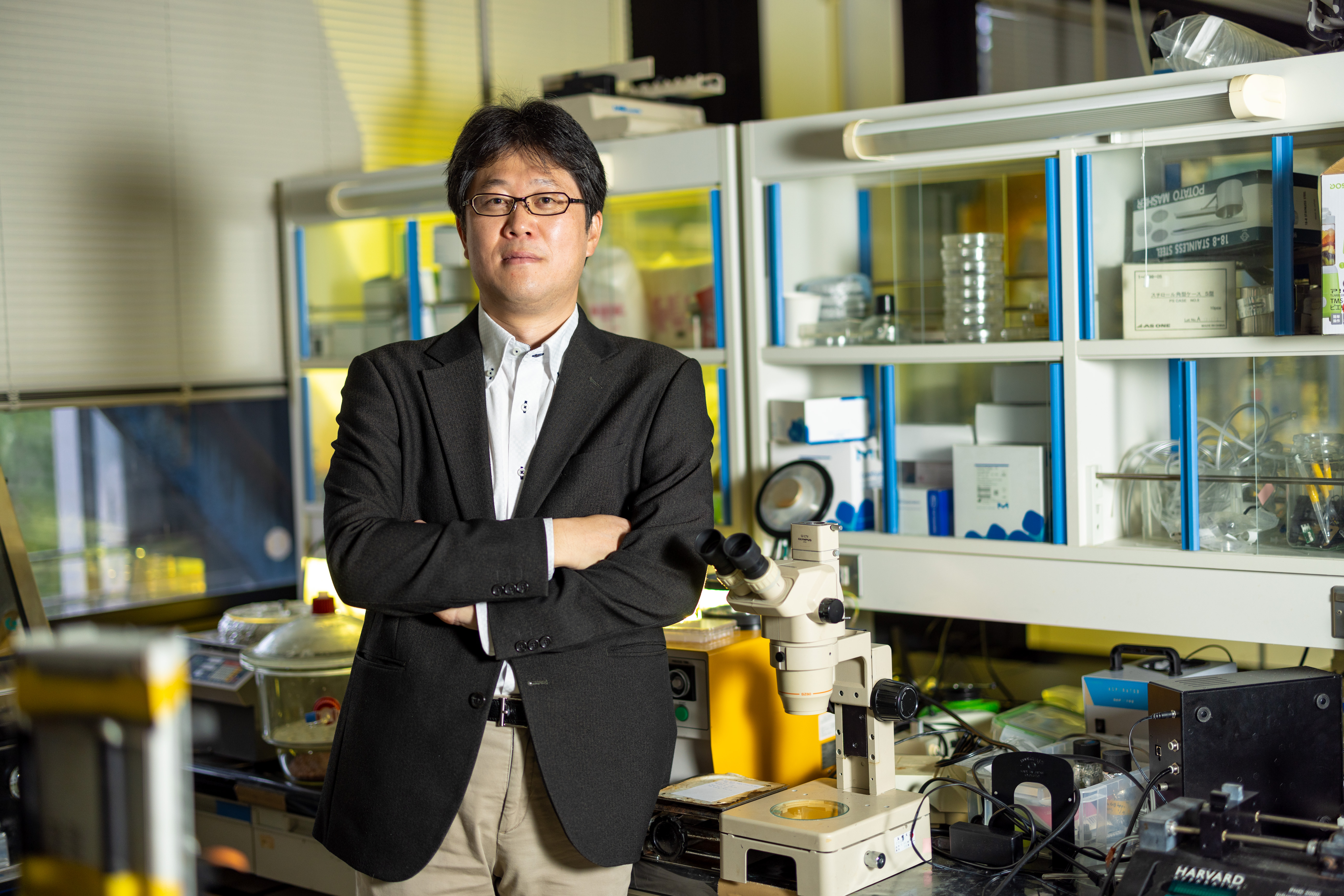
Professor Shinji Sakai, Graduate School of Engineering Science
"From naughty to nice: Magic suit transforms nasty nematodes into living drug delivery system"
Dr. Shinji Sakai and his then-graduate student, Dr. Wildan Mubarok, published a study in Materials Today Bio on the potential use of Anisakis, a nematode that has long been an undesirable creature, as a drug delivery system [1].
Seafood such as mackerel and horse mackerel are parasitized by Anisakis, which can cause stomach pain and severe food poisoning when eaten with sashimi, for example. This is well known in cultures like Japan, where seafood is eaten raw. That said, Anisakis has an interesting characteristic in that it does not die immediately after being exposed to gastric juices. It has also been reported that certain types of nematodes, including Anisakis, may be able to detect the "smell" of cancer and migrate and attach to the cancer, and recently, attempts have been made to apply this phenomenon to cancer diagnosis. There have also been reports of Anisakis attaching to gastric cancer, likely due to Anisakis’ ability to detect the "smell."
Given this background, Dr. Sakai and his research group began their study to see if the capabilities of Anisakis could be utilized to take advantage of the creature's biology and employ it for drug delivery. They concluded that the ability to detect the "smell" of cancer and move to the site of the cancer would be attractive as a transporter of substances that kill cancer cells and worked to develop a method of loading such substances onto Anisakis.
As a result, they succeeded in developing a method to form a thin film of flexible gel about 0.01 mm thick on the surface of nematodes such as Anisakis in about 20 minutes, without affecting the nematode's ability to detect odors or mobility. Just imagine the whole body of a 2-3 cm-long Anisakis being fitted with a full-body suit, kind of like a tiny superhero. The thin film is gelatinous and soft and does not interfere with the Anisakis' movements. After the suit is put on, the Anisakis remains alive, can detect the scent, and can move around freely.

Suited up and ready for action
Dr. Sakai and Dr. Mubarok were able to give the thin film the target function by changing the type of compound mixed in the aqueous solution. When they actually succeeded, Dr. Sakai says he was shocked to realize that it truly was possible.
After being coated with a gel thin film containing a material that blocks the transmission of ultraviolet light, the resistance of nematodes to ultraviolet light was improved. Furthermore, when the Anisakis were coated with a thin film containing an enzyme that generates hydrogen peroxide from glucose, the hydrogen peroxide delivered attacked the cancer cells, successfully killing them within 24 hours. Although the development of additional technologies will be necessary, the team expects that this could lead to "an alternative cancer therapy in which Anisakis searches for cancer and attacks cancer cells with the function of the suit formed on its surface."
Gel expert continues to excitedly explore the world
Dr. Sakai originally specialized in regenerative medicine and tissue engineering. For many years, he has been conducting research on adding new functions to the surface of animal cells. In fact, it was also through this research that he came up with the idea of putting an Anisakis in a thin-film suit to make it a transporter.
Dr. Sakai says that it is important to have sense of fun and to be able to pursue exciting ideas. Indeed, the projects in his lab are very wide-ranging, and the unexpected mix of topics is quite surprising: the lab has Anisakis, biomaterials, crickets, cultured meat, and 3D printers and so on. These seemingly unconnected themes are the spontaneous expansion of Dr. Sakai's intellectual curiosity with his expertise, all connected by one keyword: hydrogel.

Enjoy what is in front of you and don’t hesitate to pursue it
Dr. Sakai says he wants to continue to be a researcher who can see potential before anyone else does. In this Anisakis project, he felt pleasure in seeing the results of his team’s research, as they themselves were the first in the world to see it. Though Dr. Sakai's office is located right next to his laboratory, he has a bit of space in his own office where he tries out ideas. Valuing ideas, questions, and excitement like this, academic research by Dr. Sakai approaches questions and goes further than even he had imagined.
[1] Wildan Mubarok, Masaki Nakahata, Masaru Kojima, Shinji Sakai (2022). Nematode Surface Functionalization with Hydrogel Sheaths Tailored In Situ. Materials Today Bio.
https://doi.org/10.1016/j.mtbio.2022.100328.
For more information.
https://resou.osaka-u.ac.jp/en/research/2022/20220617_1
http://www.cheng.es.osaka-u.ac.jp/sakailabo/english/member.html
Text: Mayumi Mochizuki/Edit: Christopher Bubb